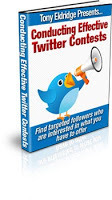7 Tips For Writing Titles That Will Cause Readers To Click On Your Post
When you write a blog post, the title may be the single most important factor in whether people will click on it and read it or not. That makes titles worth spending a little time thinking about before we slap one on and go. Here are some tips on choosing effective post titles that will work for you.
1. Use Keyword Rich Titles- Titles play an important role when search engines return results, so you want to use them as much as possible. While I have been known to write titles for other purposes, I generally try to use keywords when possible. For this reason, I also recommend that you use keywords in your blog's permalink settings rather than a post number.
2. Use Titles That Communicate A Benefit- Writing titles for search engines is important, but you also want to write for the reader who sees your post link and has a split second to decide whether to click it or move on. Benefit statements tell the reader what they will get if they read your post. For example, you could say:
7 Tips For Writing Great Post Titles
or
7 Tips For Writing Titles That Will Cause Readers To Click On Your Post
The second option has a benefit that helps the reader decide to click on the link and read what you have to say.
3. Use Lists- I love lists and apparently so do a lot of people. There is a marked improvement of my traffic when I incorporate lists into my post titles. "10 reasons to...", "5 Ways You Can..." "Top 10 Reasons Why You Need To..."
Lists are perfectly suited for blog readers who often have many blogs they look at each day. They help readers quickly scan the content and make it easy for them to digest your information. They help break down long blocks of text into easily read bits and pieces, which means your post gets a boost when looking to engage readers.
4. Ask Questions- Asking questions in your post title serves the same purpose that using lists serves. It piques the interest of the reader and promises specific answers in your post. Questions in your titles can also be a great catalyst for people to leave comments. "Which is better, Nook or Kindle?" can give you fertile material to blog about while stirring the passions of your readers. Question titles also generally do a good job in engaging Twitter followers.
5. Play On Words- Using a play on words can cause people to jump on your title or avoid it like the plague, so be careful when you employ this strategy. You have to use this title strategy in a way that legitimately ties in with your content, or readers will be disappointed. Consider these "hit" and "misses" for me with this strategy:
Hit: Marketing Lesson I Learned From My Infidelity- This post talks about creating customer loyalty by illustrating how I felt when a barista from my local Starbucks walked into a neighboring store and found me sitting there. This posts still draws in healthy traffic even though it was written in September, 2009.
Miss: Borrow Other People's Mailing List For Extended Reach- This posts has great advice for people who have no audience to tap into by giving tips on how you can get in front of other people's readers. "Borrowing" a list in this context means getting the list owner to write about you to their followers. But the title backfired on me because the play on words was not easily seen and because the play on words was on the practice of taking someone's list and sending out your own content to it (which I strongly discourage). This title generates so much negative feedback on Twitter without causing anyone to actually click on the post to read it, that I no longer actively use it. In fact, I will probably change the title soon and resubmit it, but I like it as an illustration of a poorly designed title.
6. Commentate On Current Events- You can capitalize on current media buzz by writing a post title that inserts yourself into the debate. A few week's ago, I read everything I could about Amanda Hocking, so when I saw a title with her name, I clicked on it. The downside to using this technique is that when the buzz wears off, so do the clicks. While I will use this technique once in a while, I generally opt for a long-term approach to using titles that will have timeless appeal.
7. Generate Controversy- Few things can engage people like controversy, and many use this technique to generate readers for their blog. "Why Publishing An e-Book Will Scuttle Your Author Career" may raise a few eyebrows and cause people to see what you have to say. Be ready for a healthy debate on your post if you choose this title strategy.
Before you publish your next blog post, take a look at your title. What is it doing to encourage (or discourage) people from clicking on it? What promise is it making and are you delivering on its promises? You'll find it difficult to use all of these strategies to create the perfect title, so settle on employing one or two to work for you. After a little testing, you'll find the titles that reach out to the most people and keep them coming back for more.
--------








1. Use Keyword Rich Titles- Titles play an important role when search engines return results, so you want to use them as much as possible. While I have been known to write titles for other purposes, I generally try to use keywords when possible. For this reason, I also recommend that you use keywords in your blog's permalink settings rather than a post number.
2. Use Titles That Communicate A Benefit- Writing titles for search engines is important, but you also want to write for the reader who sees your post link and has a split second to decide whether to click it or move on. Benefit statements tell the reader what they will get if they read your post. For example, you could say:
7 Tips For Writing Great Post Titles
or
7 Tips For Writing Titles That Will Cause Readers To Click On Your Post
The second option has a benefit that helps the reader decide to click on the link and read what you have to say.
3. Use Lists- I love lists and apparently so do a lot of people. There is a marked improvement of my traffic when I incorporate lists into my post titles. "10 reasons to...", "5 Ways You Can..." "Top 10 Reasons Why You Need To..."
Lists are perfectly suited for blog readers who often have many blogs they look at each day. They help readers quickly scan the content and make it easy for them to digest your information. They help break down long blocks of text into easily read bits and pieces, which means your post gets a boost when looking to engage readers.
4. Ask Questions- Asking questions in your post title serves the same purpose that using lists serves. It piques the interest of the reader and promises specific answers in your post. Questions in your titles can also be a great catalyst for people to leave comments. "Which is better, Nook or Kindle?" can give you fertile material to blog about while stirring the passions of your readers. Question titles also generally do a good job in engaging Twitter followers.
5. Play On Words- Using a play on words can cause people to jump on your title or avoid it like the plague, so be careful when you employ this strategy. You have to use this title strategy in a way that legitimately ties in with your content, or readers will be disappointed. Consider these "hit" and "misses" for me with this strategy:
Hit: Marketing Lesson I Learned From My Infidelity- This post talks about creating customer loyalty by illustrating how I felt when a barista from my local Starbucks walked into a neighboring store and found me sitting there. This posts still draws in healthy traffic even though it was written in September, 2009.
Miss: Borrow Other People's Mailing List For Extended Reach- This posts has great advice for people who have no audience to tap into by giving tips on how you can get in front of other people's readers. "Borrowing" a list in this context means getting the list owner to write about you to their followers. But the title backfired on me because the play on words was not easily seen and because the play on words was on the practice of taking someone's list and sending out your own content to it (which I strongly discourage). This title generates so much negative feedback on Twitter without causing anyone to actually click on the post to read it, that I no longer actively use it. In fact, I will probably change the title soon and resubmit it, but I like it as an illustration of a poorly designed title.
6. Commentate On Current Events- You can capitalize on current media buzz by writing a post title that inserts yourself into the debate. A few week's ago, I read everything I could about Amanda Hocking, so when I saw a title with her name, I clicked on it. The downside to using this technique is that when the buzz wears off, so do the clicks. While I will use this technique once in a while, I generally opt for a long-term approach to using titles that will have timeless appeal.
7. Generate Controversy- Few things can engage people like controversy, and many use this technique to generate readers for their blog. "Why Publishing An e-Book Will Scuttle Your Author Career" may raise a few eyebrows and cause people to see what you have to say. Be ready for a healthy debate on your post if you choose this title strategy.
Before you publish your next blog post, take a look at your title. What is it doing to encourage (or discourage) people from clicking on it? What promise is it making and are you delivering on its promises? You'll find it difficult to use all of these strategies to create the perfect title, so settle on employing one or two to work for you. After a little testing, you'll find the titles that reach out to the most people and keep them coming back for more.
--------
Tony Eldridge is the author of The Samson Effect, an action/adventure novel that Clive Cussler calls a "first rate thriller brimming with intrigue and adventure." He is also the author of the Twitter marketing book, Conducting Effective Twitter Contests.








Published on March 30, 2011 04:27
No comments have been added yet.







